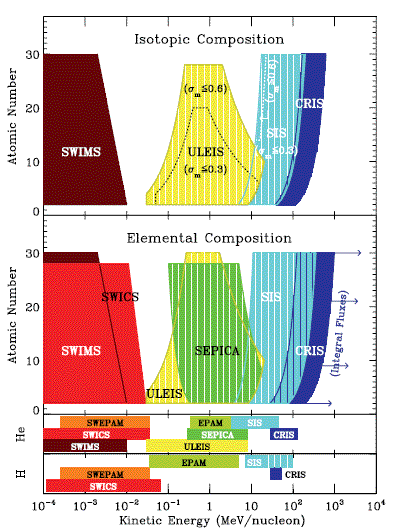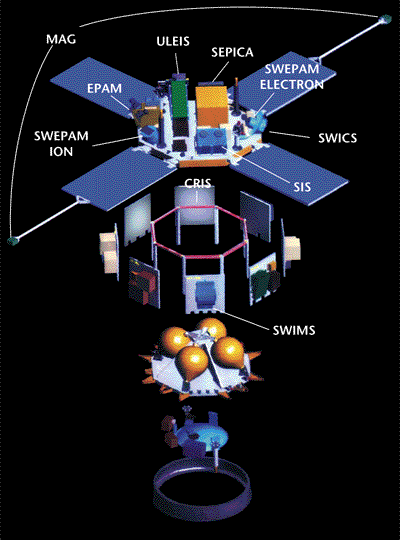

The Advanced Composition Explorer (ACE) is an Explorer mission that was managed by the Office of Space Science Mission and Payload Development Division of the National Aeronautics and Space Administration (NASA). More on the ACE personnel, including scientific Co-Investigators can be found here.
ACE launched on a McDonnell-Douglas Delta II 7920 launch vehicle on August 25, 1997 from the Kennedy Space Center in Florida.
The Earth is constantly bombarded with a stream of accelerated particles arriving not only from the Sun, but also from interstellar and galactic sources. Study of these energetic particles contributes to our understanding of the formation and evolution of the solar system as well as the astrophysical processes involved. The Advanced Composition Explorer (ACE) spacecraft carrying six high-resolution sensors and three monitoring instruments samples low-energy particles of solar origin and high-energy galactic particles with a collecting power 10 to 1000 times greater than past experiments.
ACE orbits the L1 libration point which is a point of Earth-Sun gravitational equilibrium about 1.5 million km from Earth and 148.5 million km from the Sun. From its location at L1 ACE has a prime view of the solar wind, interplanetary magnetic field and higher energy particles accelerated by the Sun, as well as particles accelerated in the heliosphere and the galactic regions beyond.
ACE also provides near-real-time 24/7 continuous coverage of solar wind parameters and solar energetic particle intensities (space weather). When reporting space weather ACE provides an advance warning (about one hour) of geomagnetic storms that can overload power grids, disrupt communications on Earth, and present a hazard to astronauts.
The spacecraft has enough propellant on board to maintain an orbit at L1 until about August 2028 ± 1 year. The uncertainty is because the amount of propellant remaining must be estimated from propellant tank pressure readings.
More details of the ACE mission can be found in the ACE Mission Paper, published in Space Science Reviews. View PDF Version (251Kb)

The prime objective of ACE is to measure and
compare the composition of several samples of matter,
including the solar corona, the solar wind, and other
interplanetary particle populations, the local interstellar medium
(ISM), and galactic matter. While there has been great progress
addressing these objectives, the changing
conditions over the solar cycle present new opportunities. In
addition, new observations and theoretical advances, new
missions, and the evolving goals of NASA and the
Heliophysics Theme have introduced new
challenges, including the goal of achieving the scientific
understanding needed to forecast space weather in the coming
years when humans will venture beyond Earth's protective
magnetosphere.
The nine scientific instruments on ACE are performing:
A more detailed list of ACE science goals
Last update: January, 2012
ACE has been at the L1 point for over 19 years, and the spacecraft and instruments are still working very well, with the exception of the SEPICA instrument. Due to failure of the valves that control gas flow through the instrument, active control of the SEPICA proportional counter was lost, and delivery of science data from SEPICA ended on Feb 4 2005. The SEPICA instrument was turned off permanently on April 20, 2011.
A fuel use strategy has been implemented that will allow continued operations through the year 2029 (see below).
As of December 2016, over 1000 peer reviewed papers have been published by ACE science team members. See the ACE Publications List for more information.
Publication-quality data from the ace instruments are available on the web from the ACE Science Center.
The ACE Education and Public Outreach (E&PO) Committee, in cooperation with the cosmic ray group at NASA GSFC, has set up a page with ACE and other E&PO material on the web at: http://helios.gsfc.nasa.gov
Over 140 Science News items have been released by the ACE Science Center.
You can check
/ACE/ACENews_curr.html
for the latest science news from ACE.
A Space Science Reviews book that contains all the ACE instrument papers has been published (vol. 86, Issue 1/4, 1998).
Also, the Advanced Composition Explorer (ACE) Lessons Learned and Final Report is out and available in pdf form (4.4 MByte).
On January 21, 1998, NOAA and the ACE project opened up the ACE Real Time Solar Wind (RTSW) monitoring capability to the public. The service provides continuous coverage of the solar wind parameters and solar energetic particle intensity. ACE's position a million miles upstream of earth gives as much as an hour's warning of CME's that can cause geomagnetic storms here at earth. See http://www.swpc.noaa.gov/products/ace-real-time-solar-wind

Three types of maneuvers (attitude, orbit and spin) have been used since July 2001 to control ACE. Orbit maneuvers use 3lbm/year of fuel per year and keep the spacecraft bound to the L1 libration point. Attitude maneuvers use 6lbm/year and are required to maintain the HGA antenna constraint. With this strategy, fuel use is less than 9 lbm/y total, and the 88 lbm of fuel remaining as of December 2016 will be consumed by year 2026 (update: now ~2029).
Initially, two Z-axis maneuvers using 16 lbm/y were used to prevent the Sun-Earth-Spacecraft (SES) angle from dropping below 4.75° due to natural evolution of the Lissajous orbit (see figure at right). This conservative Solar Exclusion Zone (SEZ) was designed to avoid solar radio interference with the downlink. As a result of discontinuing the Z-axis maneuvers after July 2001, ACE transited the SEZ with an SES angle of <2° every 3 months from September 2003 thru May 2005. Although the solar radio flux reduced the telemetry link margin to <3 dB during some of these transits, no science data were lost, as the ACE solid-state recorder has 86-hour capacity. Spacecraft commanding continued uninterrupted. Neither NASA nor NOAA has lost any data during SEZ transits, even in May 2004 when the minimum SES angle was 0.2° during a 21-hour crossing of the solar disk as viewed from Earth.
ACE again transited the SEZ with an SES angle of <2° during the 2011-2013 solar maximum, and again in 2019. Minimal data loss was experienced.
ACE was conceived at a meeting on June 19, 1983 at the University of Maryland. The meeting was hosted by George Gloecker and Glen Mason. The participants were Drs. L. F. Burlaga, S. M. Krimigis, R. A. Mewaldt, and E. C. Stone. This meeting had been preceded by preliminary documentation from the Johns Hopkins University Applied Physics Laboratory (APL) and the University of Maryland under the proposal name of Cosmic Composition Explorer. An unsolicited proposal was put together and forwarded to the NASA Explorer Program Office later that year, but was not acted upon.
The proposal was resurrected at the instigation of Dr. Vernon Jones and officially resubmitted to NASA in 1986 as part of the Explorer Concept Study Program. In 1988, the ACE mission was selected for a one-year "Phase A" (concept) Study. This study was a collaborative effort between spacecraft design and science teams.
The ACE Mission officially began on 22 April 1991 when the contract between NASA/GSFC and the California Institute of Technology was signed. APL, designer and builder of the ACE spacecraft, was involved in planning for Phase B (definition). The early ACE Spacecraft effort (April to July 1991) was primarily for ACE mission support, spacecraft system specification and ACE instrument support and interface definition. Phase B of the ACE mission officially began in August 1992.
The Mission Preliminary Design Review was held in November
1993. Phase C/D (implementation) began shortly thereafter.

The spacecraft is 1.6 meters across and 1 meter high, not including the four solar arrays and the magnetometer booms attached to two of the solar panels. At launch, it weighed 785 kg, which includes 189 kg of hydrazine fuel for orbit insertion and maintenance. The solar arrays generate about 500 watts of power. The spacecraft spins at 5 rpm, with the spin axis generally pointed along the Earth-sun line and most of the scientific instruments on the top (sunward) deck.
ACE launched on a McDonnell-Douglas Delta II 7920 launch vehicle on August 25, 1997 from the Kennedy Space Center in Florida.
In order to get away from the effects of the Earth's magnetic field, the ACE spacecraft has travelled almost a million miles (1.5 million km) from the Earth to the Earth-sun libration point (L1). By orbiting the L1 point, ACE stays in a relatively constant position with respect to the Earth as the Earth revolves around the sun.
Authors: Eric R. Christian - erc@cosmicra.gsfc.nasa.gov and Andrew J. Davis - ad@srl.caltech.edu
Last Updated: Feb 27, 2025
Return to Caltech ACE Home Page